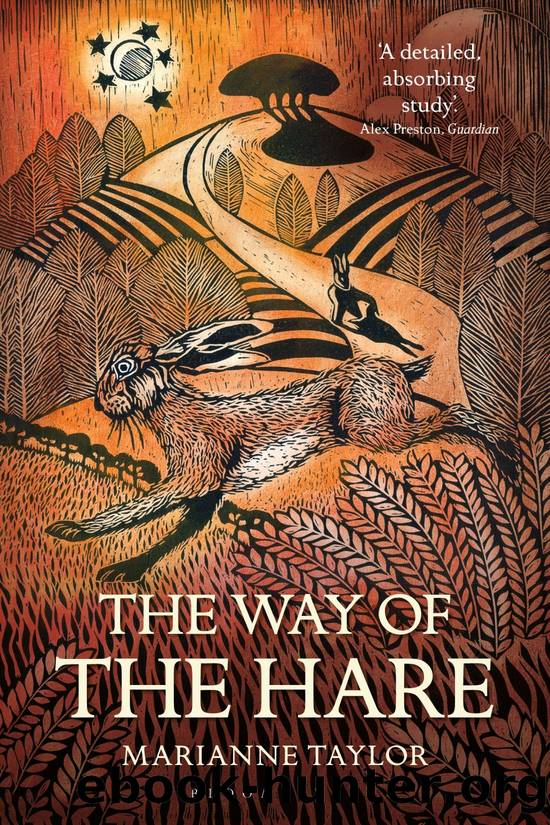The Way of the Hare by Marianne Taylor

Author:Marianne Taylor
Language: eng
Format: epub
ISBN: 9781472909909
Publisher: Bloomsbury Publishing
Lagomorphs started strongly, in evolutionary terms. As we saw in chapter 2, the ancestor of all lagomorphs diverged from the rodents sometime around 55â45 million years ago, and did very well for itself for a time, colonising the whole world and diversifying into hundreds of species. Its ability to live on grass, which few other animals can do, was key to this success. However, competition with an apparently better-adapted bunch of grass-eaters, the ungulates or hoofed mammals, slammed the brakes on lagomorph evolution. Only the most resilient and versatile lineages survived, along with a few island or otherwise isolated forms that were simply lucky enough to live somewhere that didnât have any ungulates, but their luck didnât necessarily hold out for too long.
Take, for example, the mighty Nuralagus rex, aka the âMinorcan giant lagomorphâ, biggest of all bunnies. Itâs hard to believe that this 23kg beast, native to the Balearic island of Minorca, was even a lagomorph at all. Reconstructions, based on the size and solidity of its bones, show an animal that looks more like a wombat than a rabbit â stocky, robust, hump-backed and not noticeably long-legged â it would not have been able to leap like a rabbit or hare and would have bumbled around more in the manner of a badger. Even if the reconstruction gives it a pair of big rabbit ears it still looks very little like any lagomorph, but the details of its bones insist that it was one.
The first N. rex bone was found by a 19-year-old student, Josep Quintana, whoâs now working as a paleontologist at the Institut Català de Palentologia in Barcelona, though at the time the significance of the find escaped him, as he explains: âI was not aware what this bone represented. I thought it was a bone of the giant Minorcan turtle!â It took several more years for him and his team to extract enough of a sample from the rocks to build up a real picture of what N. rex would have looked like, and how very big it was. It was the animalâs skull and teeth that confirmed its lagomorph-ness. It had, essentially, a very big but fairly standard rabbit skull, with the unique lagomorph dentition, mounted on a big cumbersome body that Quintana likened to âa beaver out of waterâ.
The ancestors of N. rex, which were almost certainly more conventional-sized lagomorphs, reached Minorca when it was connected to Spain by a land bridge, about 5.3 million years ago. They were then stuck there when the Zanclean flood took away the bridge. With no natural predators, the animals followed the âisland ruleâ â that small animals isolated on an island and in no danger of being eaten by other animals tend to get bigger â as well as becoming slower, fatter and generally less well equipped to escape danger. In other words, better adapted to a life in which there was no danger. One thing that evolution does not do well is what you might call âfuture-proofingâ.
Download
This site does not store any files on its server. We only index and link to content provided by other sites. Please contact the content providers to delete copyright contents if any and email us, we'll remove relevant links or contents immediately.
Sapiens: A Brief History of Humankind by Yuval Noah Harari(14322)
The Tidewater Tales by John Barth(12627)
Mastermind: How to Think Like Sherlock Holmes by Maria Konnikova(7281)
Do No Harm Stories of Life, Death and Brain Surgery by Henry Marsh(6908)
The Thirst by Nesbo Jo(6882)
Why We Sleep: Unlocking the Power of Sleep and Dreams by Matthew Walker(6659)
Life 3.0: Being Human in the Age of Artificial Intelligence by Tegmark Max(5519)
Sapiens by Yuval Noah Harari(5325)
The Longevity Diet by Valter Longo(5044)
The Body: A Guide for Occupants by Bill Bryson(5033)
The Rules Do Not Apply by Ariel Levy(4912)
The Immortal Life of Henrietta Lacks by Rebecca Skloot(4552)
Animal Frequency by Melissa Alvarez(4430)
Why We Sleep by Matthew Walker(4395)
The Hacking of the American Mind by Robert H. Lustig(4342)
Yoga Anatomy by Kaminoff Leslie(4334)
All Creatures Great and Small by James Herriot(4277)
Double Down (Diary of a Wimpy Kid Book 11) by Jeff Kinney(4244)
Embedded Programming with Modern C++ Cookbook by Igor Viarheichyk(4143)
